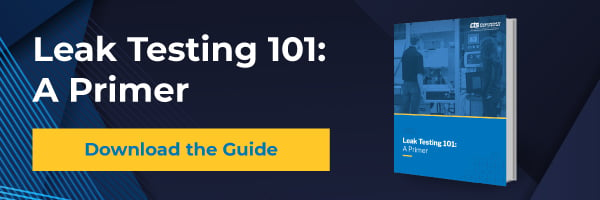Pressure Decay Test Method Guide
There are many different types of leak testing, so when you must test for leaks in the factory or the field, it pays to know which leak test is best for the task. Pressure decay testing is one of the most popular forms of leak testing because it is accurate and relatively easy.
Pressure decay leak testing uses a pressure loss measurement to identify a specific leak rate, making it one of the most effective means of testing for leaks in virtually any type of part. It is a simple test that is easy to automate and ideal for isolating even the smallest leaks. You can conduct pressure decay testing using either air pressure or a vacuum.
Applications for Pressure Decay Leak Testing
As the name suggests, pressure decay leak testing detects leaks by measuring changes in pressure either inside or outside of a part. Everything leaks to some degree, so pressure decay testing determines whether the size of the leakage is within tolerance. Overall, it is the best test to realize a quantitative measure for fluid leaks.
Pressure decay testing is relatively easy, fast, and inexpensive, so it is often used in high-volume production industries. For example, it is used in automotive production to measure leakage in oil pans, engine blocks, cylinder heads, and other parts. Pressure decay testing is also used in testing medical devices, castings, appliances, consumer goods, and more. It can work well for both large and small parts.
How Pressure Decay Testing Works
Conducting a pressure decay leak test is a relatively simple process. First, you need to seal the part to be tested. This is necessary so the part can either be pressurized or have its air evacuated to test for leaks.
Second, once the part is pressurized, it must be isolated from the pressure source. The change in pressure is measured over time to determine the leak rate, which can be expressed as a pressure loss over time or correlated to standardized volumetric flow (scc/min).
To ensure an accurate pressure decay test, you must establish specific test standards. For example, you want to establish load and unload times (i.e., the time to engage and disengage from the test). Although this may not impact the test results, it will impact the overall test time. You also want to establish a settling time to stabilize the pressure of the part and a minimum time to charge the part to ensure that optimal pressure is reached.
By establishing and maintaining a common set of test standards, you will get more accurate, consistent test results. Repeatable conditions also make it easier to obtain comparative results.
Variables that Affect Pressure Decay Testing
Any time you test for leaks, you want to compensate for factors that may prevent accurate, repeatable results. There are several variables in pressure decay testing that can impact outcomes:
- Time: You need to allow sufficient time for the test pressure to stabilize. To get consistent results, you must ensure the gas pressure has penetrated every nook and cranny in the test part.
- Temperature: Temperature changes will affect the pressure measurement during testing. The pressurization process itself generates heat and must be stabilized prior to testing.
- Elasticity: Some parts are elastic and stretch under pressure, so they need a longer settle time to reach a stable pressure.
- Porosity: Porosity can affect pressure. If the part under test can absorb the gas used for testing, you must compensate for the absorption rate.
- Debris: Watch for part debris that can cause excessive seal wear. Additionally, when pressure is released, loose particles can carry with the expelled gases, collect in the test instrument, and damage the test instrumentation valve seals.
For accurate, repeatable test results, you must have a long enough settle time to ensure the test part is stable. The settle time will vary based on conditions. For example, larger parts require a longer fill and test time. If the leak rate is decreased, you should increase your test time to get an accurate measurement. Increasing the test time will promote repeatable results, especially with flexible or porous parts that need longer to stabilize.
Benefits of Vacuum Leak Testing
You may want to use a vacuum instead of pressure for testing. The procedure is the same as pressure decay testing, only you extract air to create a vacuum rather than pressurize the part.
Vacuum leak testing is particularly useful for parts that are difficult to seal. It also reduces the required test time when faced with porous parts or thermal changes, increasing test accuracy. Additionally, vacuum leak testing provides more accurate, repeatable results when testing lower pressure parts.
The best way to approach any leak testing—including pressure decay testing—is to create a stable test environment. You want testing tools that are accurate and deliver repeatable results. You also want to eliminate as much background noise as possible, meaning the test environment should be free of dust or interfering materials and have a stable temperature and controlled humidity.
Subtle factors can impact leak test results. Pressure decay testing is one of the most accurate leak tests available, but you still need to take precautions to ensure you have a stable, controlled test environment.
For more information about pressure decay leak testing, check out our blog posts and educational webinar.
You can also download our latest guide, Leak Testing 101: A Primer, or contact us with any questions you might have.



